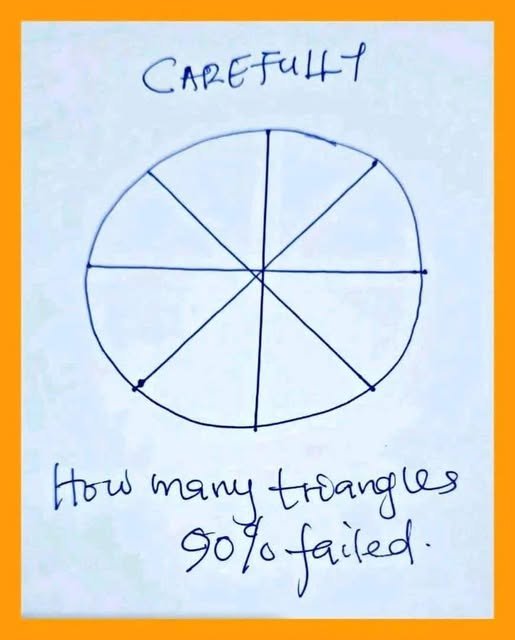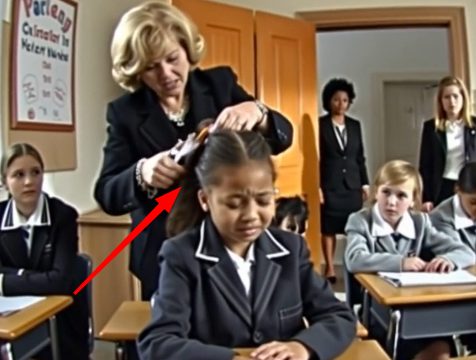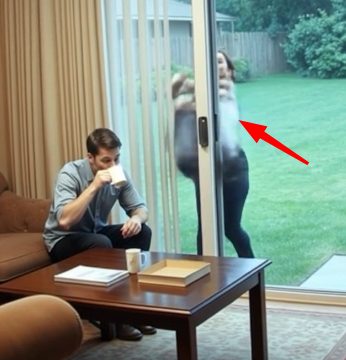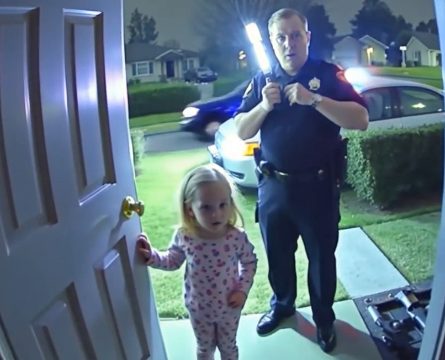At first glance, the image appears incredibly straightforward—a circle neatly divided into eight equal sections, almost like a perfectly sliced pizza. The challenge posed is simple: “How many triangles?” But here’s the catch—while it may seem like just another easy geometry puzzle, it’s actually a clever test of perception, attention to detail, and how well you read between the lines. According to the original post, a whopping 90% of people fail to solve it correctly. So the question is, can you beat the odds?

Let’s dive into why this brain teaser trips up so many people. The initial instinct for most is to count the triangular-looking segments created by the intersecting lines in the circle. But that’s where the first mistake often happens. The puzzle asks for the number of triangles—not slices, not sections. That small distinction is what throws people off. Many folks rush through the problem because it looks easy, but a closer examination reveals there’s more here than meets the eye. Some triangles are hidden in unexpected ways—not just in the image but also in the language used to present the puzzle.
Now let’s work through the solution step-by-step to understand exactly where all the triangles are hiding.
Step 1: Identify the Triangles in the Circle
The circle is split into eight parts by four lines—two diagonals, one vertical, and one horizontal. However, not all these divisions actually create triangles. When you focus on the center where these lines meet, you’ll notice a few wedge-shaped forms. These do resemble triangles, but how many are there really? Upon close inspection, we find three distinct triangle-shaped sections in the very center of the circle. These are the only legitimate geometric triangles present in the actual drawing.
✔️ Count so far: 3 triangles from the image.
Step 2: Hidden Triangle in the Text
Here’s where things start to get clever. The question asks, “How many triangles?” The word triangle itself is written out in the sentence—and believe it or not, that counts as another triangle. While it’s not a geometric shape, it’s a representation of a triangle in word form, which this puzzle cleverly includes as part of the total.
✔️ Add 1 more triangle (the word “triangle”).
Step 3: The Trick Hidden in Typography
The next sneaky triangle comes from the word “CAREFULLY,” which appears above the image in the original puzzle. If you look closely, you’ll notice the letter “A” in “CAREFULLY” is shaped like a triangle. This symbolic triangle isn’t a drawn figure but is still considered part of the puzzle. It’s a mental nudge to look beyond just the lines and shapes—to observe how even letters can play a role in visual trickery.
✔️ Add another triangle for the letter “A” in “CAREFULLY.”
Total Triangle Count:
-
3 geometric triangles from the center of the circle
-
1 triangle from the word “triangle” in the question
-
1 symbolic triangle from the letter “A”
✅ Final Answer: 5 Triangles
Why This Puzzle Is So Brilliant
What makes this puzzle so effective is how it blends visual cues with textual clues. It’s not just testing your ability to count shapes—it’s measuring your ability to interpret a question thoughtfully, to consider possibilities beyond the obvious, and to spot hidden meanings. It’s a classic example of lateral thinking, where the solution isn’t just about what you see but how you understand what you’re being asked.
The reason 90% of people get it wrong? Most approach it too literally or too hastily. They focus only on the visible shapes and overlook the subtle hints embedded in the language. This kind of puzzle forces you to slow down and think differently—which is what makes it such a fun and rewarding challenge.
How Did You Do?
Now that you’ve seen the full breakdown, think back to your original guess. Did you count all five triangles? Did you miss the hidden ones in the text or the symbolic shape of the letter? Whether you nailed it or got stumped, puzzles like this are excellent exercises for sharpening your brain and thinking outside the box.
Feel free to share your first answer in the comments, and more importantly—challenge your friends! See if they can beat the 90% failure rate. It’s a fun way to see who really pays attention to details.
Looking for More Puzzles Like This?
If this triangle challenge piqued your curiosity, there’s a whole world of riddles, brain teasers, and optical illusions waiting to test your mental agility. Not only are they entertaining, but regularly solving puzzles has real cognitive benefits. It helps boost your focus, pattern recognition, and problem-solving skills. It’s like a gym workout—but for your brain.
So next time you’re about to scroll aimlessly through your feed, why not put your brain to work instead? Keep solving, stay sharp, and remember—the smartest solutions often come from seeing things in a completely new light.





